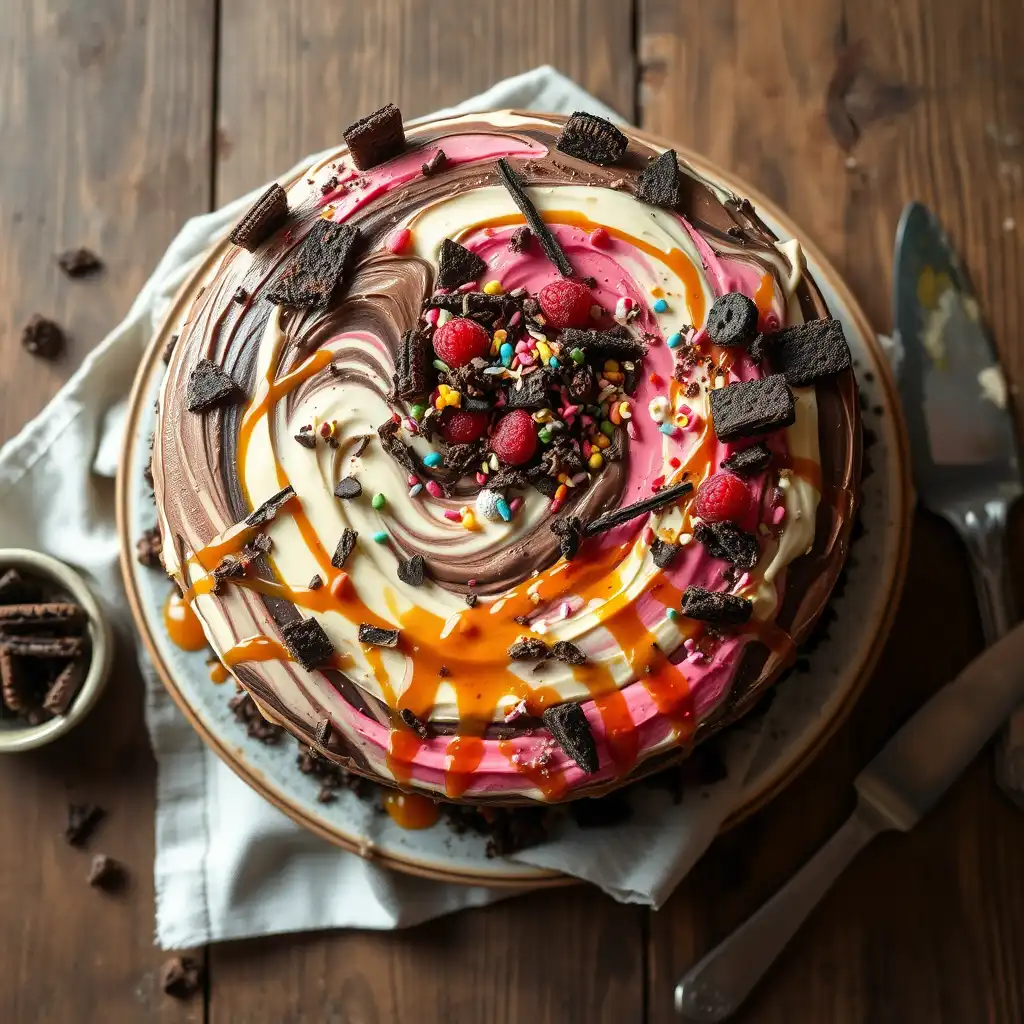Chaos cake recipe is one of those kitchen legends that feels like it shouldn’t work but somehow always does. I remember the first time I tried to bake one, I thought I’d ruined the batter. Too much going on, too many flavors colliding, swirls running everywhere. But when it came out of the oven? It was wild perfection—crispy edges, gooey middle, and a mash-up of tastes that felt like a party in the mouth.
Chaos cake recipe isn’t a traditional style cake with neat layers or pristine piping. It’s a rebel. A cake that thrives on throwing together what you have—chunks of cookies, swirls of caramel, chocolate bits, sprinkles, fruit, marshmallows. The “chaos” is the beauty. Every slice is a different bite, no two exactly the same. That unpredictability makes it oddly comforting.
Chaos cake recipe also has this cultural appeal—it’s rooted in thrift baking, the kind of “use what you’ve got” mindset. Home bakers would take leftover sweets and fold them into a batter. It’s part nostalgia, part invention, and part kitchen chaos turned into edible gold. Professionals love it because it challenges the palate, forces balance, and teaches restraint even in excess.
Ingredients & Substitutions
Chaos cake recipe usually starts with a simple vanilla or yellow cake base. Think of it as the canvas. Here’s a structured ingredient list, but remember—you’re encouraged to swap and add chaos.
- 2 ½ cups all-purpose flour (cake flour works too, for lighter crumb)
- 1 tbsp baking powder
- ½ tsp baking soda
- ½ tsp salt
- 1 cup unsalted butter, softened
- 1 ½ cups granulated sugar
- 4 large eggs, room temperature
- 1 cup sour cream or Greek yogurt (adds tang + moisture)
- 1 tbsp vanilla extract
- ½ cup whole milk
Now, the chaos mix-ins (choose 3–5, no more or it really will turn into a brick):
- 1 cup chopped chocolate (milk, dark, or white)
- ½ cup caramel or peanut butter swirls
- 1 cup crushed cookies, pretzels, or crackers for crunch
- 1 cup chopped fruit (berries, bananas, or dried fruit)
- ½ cup marshmallows or toffee bits
- ½ cup sprinkles, coconut, or nuts
Chaos cake recipe allows substitutions: gluten-free flour blends can replace all-purpose flour but increase moisture with an extra egg. Vegan bakers can swap butter with coconut oil or plant butter, sour cream with coconut yogurt, eggs with flaxseed “eggs.” For sugar-conscious eaters, coconut sugar or monkfruit blends add sweetness without the same glycemic punch.
Chaos cake recipe also thrives on ingredient quality. Fresh berries over frozen if you want bright pops of flavor. Good butter for richness. High-quality chocolate for depth. This cake exposes bad ingredients quickly because every bite is a surprise—you don’t want a disappointing chunk to ruin the chaos.
Step-by-Step Instructions
Chaos cake recipe begins like any standard cake. But small things matter here.
- Preheat oven to 350°F (175°C). Grease and line a 9×13 pan or two round pans.
- Whisk flour, baking powder, baking soda, and salt. Dry mix needs to be uniform. No lumps.
- Cream butter and sugar until pale, fluffy, and a little glossy. This step traps air—skip it and the cake sinks.
- Beat in eggs one at a time. Don’t rush; overbeating here can toughen crumb.
- Add sour cream and vanilla. Then alternate adding dry ingredients and milk. Batter should be thick but pourable.
- Fold in chaos mix-ins gently. Overmix and you’ll crush textures into mush. Swirl sauces like caramel or peanut butter just once or twice. Resist the urge to keep stirring—it should look messy.
- Pour into prepared pan. Bake 40–45 minutes, until a toothpick comes out with just a few moist crumbs.
Chaos cake recipe often goes wrong when bakers add too many mix-ins. The structure of the cake can’t hold endless chunks. The sweet spot is 3–5. Another mistake? Mixing them all evenly. The point is randomness. Let some bites be rich with chocolate, others salty from pretzels.
Chaos cake recipe can also be baked in muffin tins for individual servings, or layered in jars for trendy dessert gifting. For a spicier kick, toss in cinnamon, cardamom, or a pinch of chili powder—it shocks the sweet.
Cooking Techniques & Science
Chaos cake recipe relies on creaming butter and sugar to form structure. This step beats air into fat, which expands in the oven, giving lift. If butter is too cold, the mix won’t whip properly. Too warm, and it turns greasy. Room temperature butter is that sweet middle ground.
Chaos cake recipe uses sour cream or yogurt because of acidity. That acidity reacts with baking soda to produce carbon dioxide, which makes the crumb tender and fluffy. Skip it and you’ll notice a drier cake. Professionals use cultured dairy here for both tang and lift.
Chaos cake recipe depends heavily on folding. Folding prevents deflating the trapped air. Stirring vigorously after adding chaos ingredients will knock out air bubbles and make the cake dense. Use a spatula, lift batter from bottom, and turn gently. Think of it like cradling.
Chaos cake recipe also plays with textures. The contrast of gooey caramel against crunchy pretzels against soft crumb is what makes it exciting. It’s sensory chaos. The science of this contrast lies in fat and sugar content—caramel melts into batter, pretzels stay dry and crunchy, marshmallows puff then collapse into sticky craters.
Chaos cake recipe benefits from metal pans over glass. Metal conducts heat better, giving sharp edges and crisp crusts, while glass retains heat and can overbake edges before the middle is set.
Serving & Pairing Suggestions
Chaos cake recipe almost demands a messy, carefree plating. Slice it in squares, don’t fuss. Serve with a scoop of ice cream, maybe vanilla bean or salted caramel. The ice cream melts into the warm cake, amplifying the chaos.
Chaos cake recipe pairs well with bitter coffee or espresso. That bitterness balances the sugar. For an evening setting, a sweet dessert wine like Moscato or a nutty sherry compliments the flavors. Even a bold stout beer plays nice, its roasted malt echoing the chocolate chunks.
Chaos cake recipe works beautifully for parties. Every guest gets a different experience. Some slices might be heavy on sprinkles, others oozing caramel. That unpredictability turns it into conversation food. Kids especially adore it—it feels like a candy store trapped in a cake.
Chaos cake recipe can also be refined. Imagine plating a slice with a drizzle of ganache, a sprinkle of sea salt, and a quenelle of whipped cream. Suddenly chaos feels gourmet. Professionals love that tension—the casual gone elegant.
Conclusion
Chaos cake recipe is more than just a messy cake. It’s a philosophy of baking without boundaries, embracing imperfection, and letting flavors collide. Professionals appreciate it not only for the fun but also for the technical challenge—balancing moisture, structure, and texture without letting it collapse.
Chaos cake recipe teaches restraint, ironically. Too much chaos ruins it. Just enough, and it becomes one of the most fun cakes to eat and serve. It’s the reminder that food doesn’t need to be perfect to be memorable.
FAQs
What makes chaos cake different from regular cake?
Chaos cake is unique because it combines multiple mix-ins like chocolate, cookies, fruit, or caramel into one base batter, creating unpredictable flavors and textures.
Can chaos cake be made ahead of time?
Yes, chaos cake keeps well for 3–4 days at room temperature when wrapped tightly, and it can be frozen for up to 2 months.
How do I stop chaos cake from becoming too dense?
Limit mix-ins to 3–5 choices and fold them gently into the batter without overmixing, so the cake maintains structure.
Can I make chaos cake gluten-free or vegan?
Yes, use a gluten-free flour blend with added moisture (like an extra egg or applesauce), and swap eggs with flax eggs, butter with coconut oil, and sour cream with coconut yogurt.
What’s the best pan for baking chaos cake?
Metal pans work best because they conduct heat evenly and give a nice crisp edge, whereas glass can cause uneven baking.

Olivia P. is a seasoned food blogger at Tastywink, sharing delicious, easy-to-follow recipes inspired by him passion for home cooking. With years of culinary blogging experience, he brings flavor, creativity, and a personal touch to every dish.
